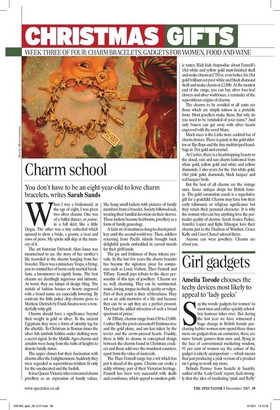Charm school: You don't have to be an eight-year-old to love charm bracelets, writes Sarah Sands
When I was a bridesmaid, at the age of eight, I was given two silver charms. One was of a ballet dancer, en pointe, in a full skirt, like a little Degas. The other was a tiny cathedral which opened to show a bride, a groom, a vicar and rows of pews. My spirits still skip at the memory of it.
The art historian Deborah Alun-Jones was mesmerised to see the story of her mother's life recorded in the charms hanging from her bracelet. There was a miniature Vespa, a fryingpan to remind her of burnt early marital breakfasts, a lawnmower to signify home. The best charms are dazzlingly ingenious and intimate. At worst, they are lumps of design bling. The initials of fashion houses or hearts engraved with a brand name are especially lowering. By contrast, the little poker chip charms given to Marlene Dietrich by Frank Sinatra were a wonderfully witty gift.
Charms should have a significance beyond their weight in gold or silver. To the ancient Egyptians they were a form of identity tag for the afterlife. To Christians in Roman times the silver fish symbols hidden under clothing were a secret signal. In the Middle Ages charms and amulets were hung from the belts of knights to denote family status.
The upper classes lost their fascination with charms after the Enlightenment. Suddenly they were regarded as superstitious trinkets fit only for the uneducated and the foolish.
It was Queen Victoria who reinvented charm jewellery as an expression of family values.
She hung small lockets with pictures of family members from a bracelet. Society followed suit, wearing their familial devotion on their sleeves. These lockets became heirlooms, jewellery as a form of family genealogy.
A faint air of mustiness clung to charm jewellery until the second world war. Then, soldiers returning from Pacific islands brought back delightful jewels embedded in carved metals for their girlfriends.
The joy and friskiness of these tokens prevails. In the last few years the charm bracelet has become the signature piece for companies such as Louis Vuitton, Theo Fennell and Tiffany. Fennell pays tribute to the sheer personality of this type of jewellery: 'Charms are so, well, charming. They can be sentimental, ironic, loving, tongue in cheek, quirky or vulgar. Part of their point is their arbitrariness. They act as an aide-memoire of a life and because they can be so apt they are a perfect present. They had the added attraction of such a broad spectrum of prices.'
At Tiffany, charms range from £50 to £5,000. I rather like the jewel-encrusted Christmas tree and the gold plane, and am less taken by the terrier and the arrow-pierced hearts. Frankly, there is little to choose in conceptual design between the charms found in Christmas crackers and those sold over the swankiest counters, apart from the value of materials.
The Theo Fennell range has a wit which has put it ahead of the game. Charms can evoke a sickly whimsy, part of their Victorian heritage. Fennell has been very successful with skulls and crossbones, which appeal to modern gothic tastes. Rich kids rhapsodise about Fennell's 18ct white and yellow gold matt-finished skull and snake charm at £750 or, even better, his 18ct gold brilliant cut pave white and black diamond skull and snake charm at £2,800. At the modest end of the range, you can buy silver four-leaf clovers and silver wishbones, a reminder of the superstitious origins of charms.
The charms to be avoided at all costs are those which are simply tattoos in a portable form. Most jewellers make them. But why do you need to be reminded of your name? And only boxers can get away with silver hearts engraved with the word Mum.
Much nicer is the Links store cocktail bar of charm choices. There is gaiety in the gold stilettos or flip-flops and the tiny multistriped handbags in 18ct gold and enamel.
At Cartier, there is a heartstopping beauty to the cloud, rain and sun charm fashioned from white gold, yellow gold and white and yellow diamonds. I also yearn for the 18ct white gold, 18ct pink gold, diamonds, black lacquer and red lacquer birds.
But the best of all charms are the vintage ones. Scour antique shops for British history. The gold coronation coach is a superlative gift for a godchild. Charms may have lost their early talismanic or religious significance but they retain their personal character. It is why the women who can buy anything love the particular quality of charms. Sarah Jessica Parker, Jennifer Lopez and Kylie Minogue love their charms just as the Duchess of Windsor, Grace Kelly and Coco Chanel adored theirs.
Anyone can wear jewellery. Charms are about you.

























































 Previous page
Previous page